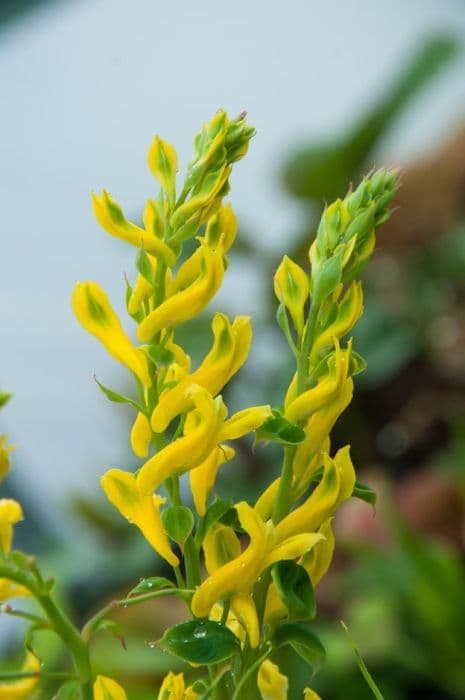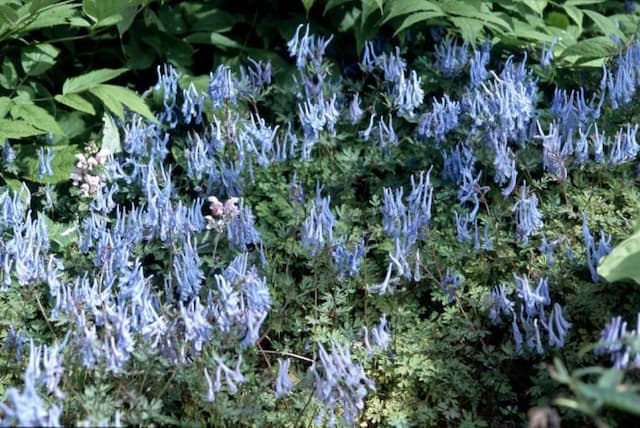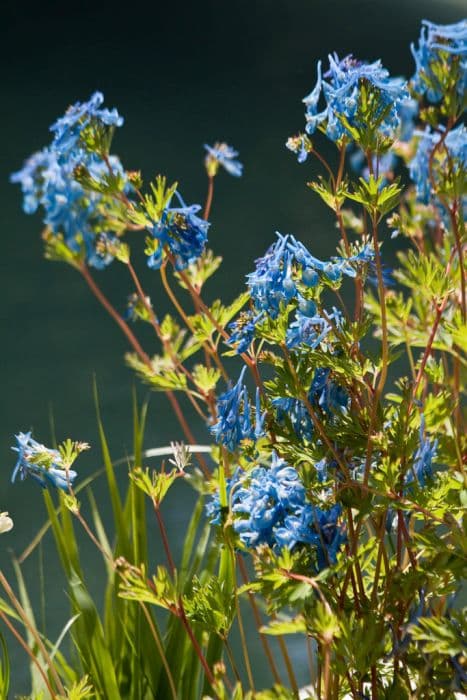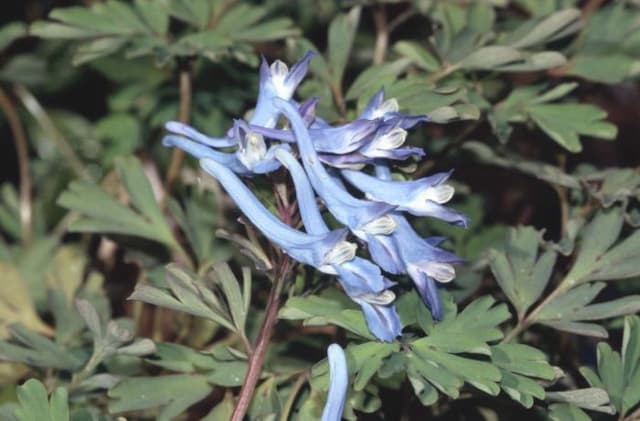Bleeding heart Dicentra 'King of Hearts'

ABOUT
Dicentra 'King of Hearts' is a charming perennial known for its graceful appearance and heart-shaped flowers. The plant features a mounding habit with bluish-green fern-like foliage that provides a delicate texture in the garden. The enchanting flowers dangle from arching stems above the foliage and have a romantic look, with their blooms resembling little hearts. The petals are rosy-pink to red in color and have a soft, almost velvety appearance. These blossoms are neatly lined up along the stem, creating an airy, whimsical effect as they sway gently in the breeze. The unique shape and vibrant hue of the flowers make King of Hearts a distinctive and attractive addition to any garden space, where it adds a touch of elegance and a splash of color.
About this plant
 Names
NamesFamily
Papaveraceae
Synonyms
King of Hearts, Bleeding Heart, Fern-Leaf Bleeding Heart
Common names
Dicentra 'King of Hearts'.
 Toxicity
ToxicityTo humans
Bleeding heart is mildly toxic to humans if ingested. Eating the foliage or flowers can cause symptoms such as nausea, vomiting, diarrhea, and skin irritations. It is important to avoid consuming any part of the plant, and wearing gloves when handling it may help prevent skin irritation.
To pets
Bleeding heart is also toxic to pets, particularly dogs, cats, and horses. Ingesting the plant can lead to similar symptoms as in humans, such as drooling, nausea, vomiting, and diarrhea. More severe cases might include tremors or even seizures. Avoid allowing pets to chew on or ingest any part of the plant to prevent these potential consequences.
 Characteristics
CharacteristicsLife cycle
Perennials
Foliage type
Deciduous
Color of leaves
Green
Flower color
Pink
Height
0.5-1 feet (15-30 cm)
Spread
1-1.5 feet (30-45 cm)
Plant type
Herb
Hardiness zones
5
Native area
Asia
Benefits
 General Benefits
General Benefits- Attracts Pollinators: Dicentra 'King of Hearts' is known to attract bees and butterflies, which are beneficial for pollinating garden plants.
- Easy to Grow: This plant is considered low maintenance, making it suitable for gardeners of all skill levels.
- Shade Tolerance: It flourishes in partial to full shade, offering a flowering option for darker areas of the garden.
- Spring Bloomer: It produces heart-shaped flowers in spring, providing early season color.
- Deer Resistant: The plant is not favored by deer, reducing the risk of damage in areas with deer populations.
- Drought Tolerant: Once established, it can tolerate periods of dryness, requiring less frequent watering.
- Long Blooming: Dicentra 'King of Hearts' has a long flowering period, which can last several weeks.
- Herbaceous Perennial: As a perennial, it will return year after year without the need for replanting.
- Compact Size: Its smaller stature makes it suitable for borders, containers, and small gardens.
- Non-Invasive: It tends to remain contained within its space without spreading aggressively.
- Aesthetic Appeal: The fern-like foliage and distinct flowers add unique textures and forms to garden landscapes.
 Medical Properties
Medical PropertiesThis plant is not used for medical purposes.
 Air-purifying Qualities
Air-purifying QualitiesThis plant is not specifically known for air purifying qualities.
 Other Uses
Other Uses- Dicentra 'King of Hearts', also known as bleeding heart, can be used in cut flower arrangements for its unique heart-shaped flowers and adds a romantic touch to bouquets and centerpieces.
- In photography, the distinct shape and vibrant color of bleeding heart flowers make them excellent subjects for macro photography to capture the intricate details of nature.
- Due to their appealing aesthetics, bleeding hearts can serve as an inspiration for artists and can be depicted in paintings, illustrations, and textile designs.
- In themed garden designs, bleeding hearts are perfect for creating a 'Valentine's Day' theme area due to their heart-shaped blooms and symbolic association with love.
- Bleeding hearts can be used as a natural indicator of the changing seasons in temperate climates as they bloom in spring signaling the end of cold weather.
- The plant can be used in educational settings such as schools and botanical gardens to teach about plant morphology due to its unique flower structure.
- Ecologically, bleeding hearts can be planted to attract pollinators like bumblebees and hummingbirds, helping to support local ecosystems.
- In folklore and storytelling, the bleeding heart plant can be incorporated into stories and myths due to its dramatic appearance and symbolism.
- As a gift, a potted bleeding heart plant can be shared with loved ones as a living symbol of affection and care.
- For hobbyists, propagating bleeding hearts from cuttings or division can be a satisfying gardening activity, allowing them to share plants with fellow enthusiasts.
Interesting Facts
 Feng Shui
Feng ShuiThe Bleeding Heart is not used in Feng Shui practice.
 Zodiac Sign Compitability
Zodiac Sign CompitabilityThe Bleeding Heart is not used in astrology practice.
 Plant Symbolism
Plant Symbolism- Love and Romance: The Dicentra 'King of Hearts', commonly known as Bleeding Heart, has heart-shaped flowers, making it a symbol of love and romance. Its unique appearance is often associated with deep emotion and affection.
- Compassion and Empathy: The 'bleeding' aspect of the Bleeding Heart flower suggests compassion and empathy, as the heart appears to express its feelings openly, offering an emblem of sensitivity and understanding.
- Elegance and Grace: The arching stems and delicate flowers of the plant convey a sense of elegance and grace, representing the beauty and refinement in emotions and personal connections.
- Rejected Love: In some interpretations, the Bleeding Heart can symbolize rejected love, with the 'bleed' conveying a sense of sorrow and the pain of love that is not reciprocated.
- Mystical and Magical: The distinctive shape and appearance of the flower may represent the mystical and magical side of love, evoking a sense of wonder and intrigue in the realm of emotions.
 Water
WaterBleeding heart 'King of Hearts' prefers consistent moisture but dislikes being waterlogged. Water the plant when the top inch of soil feels dry to the touch, which typically means watering approximately once a week during active growth periods in spring and summer. Depending on weather conditions, this may equal about one gallon of water per week for a medium-sized plant. Decrease watering frequency as the plant goes dormant in late summer or early fall. During its dormancy, water sparingly, just enough to keep the soil from completely drying out.
 Light
LightThe Bleeding heart 'King of Hearts' thrives in partial shade where it can receive dappled sunlight or light morning sun followed by afternoon shade. Avoid placing it in full, direct sunlight, especially during the hot midday hours, as this can cause stress and leaf scorch. An ideal spot is under the canopy of deciduous trees where it will receive filtered light.
 Temperature
TemperatureBleeding heart 'King of Hearts' grows best in temperatures between 55°F and 75°F, which are typical of spring to early summer weather in temperate climates. It can withstand temperatures down to freezing but prefers not to be in prolonged periods of heat above 80°F. Provide a cool environment during dormancy.
 Pruning
PruningBleeding heart 'King of Hearts' benefits from pruning to remove spent blooms and encourage a tidier appearance. Prune immediately after flowering in late spring or early summer. Deadheading is optional but can prevent self-seeding and may lead to a second, though less vigorous, bloom period. Cut back dead foliage in fall to keep the plant looking tidy.
 Cleaning
CleaningAs needed
 Soil
SoilThe best soil mix for Bleeding Heart 'King of Hearts' is well-draining, fertile loam with added organic matter such as compost. The ideal pH for the soil should be between 6.0 to 7.0 to ensure healthy growth.
 Repotting
RepottingBleeding Heart 'King of Hearts' typically doesn’t need frequent repotting and can be repotted every 2-3 years to refresh the soil or if it has outgrown its current container.
 Humidity & Misting
Humidity & MistingBleeding Heart 'King of Hearts' thrives in average to high humidity but can tolerate a range of humidity conditions as long as the soil moisture is maintained adequately.
 Suitable locations
Suitable locationsIndoor
Place in bright, indirect light and maintain moist soil.
Outdoor
Partial shade, enriched soil, keep soil moist.
Hardiness zone
5-9 USDA
 Life cycle
Life cycleThe life of Dicentra 'King of Hearts', commonly known as Bleeding Heart, begins with seed germination, which is often erratic and can take several weeks. Once the seed has sprouted, the plant enters a vegetative growth stage marked by the development of characteristic fern-like foliage and a strong root system. As spring approaches, Bleeding Heart enters the flowering phase, producing heart-shaped pink and white flowers that attract pollinators and may last through early summer. After blooming, the plant sets seed, which is then dispersed by wind or other means, completing its reproductive cycle. During late summer or fall, the foliage typically dies back as the plant enters dormancy, conserving energy for the next growing season. With the onset of cooler temperatures and diminishing light, the plant remains dormant throughout winter until environmental conditions become favorable for a new growth cycle in spring.
 Propogation
PropogationPropogation time
Spring-Early Summer
Dicentra 'King of Hearts', commonly known as Bleeding Heart, is typically propagated by division. The best time to propagate this herbaceous perennial is in late fall or early spring when the plant is dormant. To propagate by division, carefully lift the clump of the plant from the ground using a garden fork or shovel. You'll want to gently separate the plant into smaller sections, making sure each division has at least one growth bud. After division, replant the sections immediately at the same soil depth they were growing before, and water them thoroughly. It's important to keep the new divisions well-watered until they are established, which means maintaining evenly moist soil while they grow in their first season.









